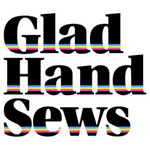Color Connection Quilt Pattern Construction Tips
Sometimes quilters like to be challenged and they seek out difficult patterns or techniques. I fall into this category. I’m always wanting to try new sewing techniques and challenging myself to figure out the best way to construct a tricky design. But, I also know sometimes we just want to make a cool quilt, and we want it to be as painless as possible.
Color Connection at QuiltCon 2022
The original version of Color Connection hanging at QuiltCon 2022.
When I was developing the pattern for the Color Connection quilt, I sewed dozens of test blocks, adjusted my template size, tried different approaches to construction. I did this because I wanted to make sewing the pattern to be as simple as possible for any quilter despite their level of experience. The result is a modern pattern that goes together with little fuss (or, at least, I hope that’s the experience you have).
My top tips for curved piecing
The block size in the PDF quilt pattern is larger than my original version of the Color Connection quilt. I did this because smaller curves can be challenging to sew. And, because there are so many curves in this quilt, I’ve also included an introduction to curve piecing in the pattern.
You can find a summary of my top tips for curve piecing in this quick video.
Assembling Block 2
The Color Connection quilt pattern is made up of two blocks and most of the pieces are cut using templates. Block 2 has several pieces and is constructed in two halves (similar to a half-square triangle block). I chose this construction method because I wanted to avoid Y-seams (three cheers for no Y-seams!).
To construct Block 2, you’ll need the pieces cut using templates 3, 4 and 5, as well as some half-square triangles cut from the background fabric. The video below shows a quick overview of how all the pieces come together.
Trimming Block 2
One key step in Block 2 is trimming the blocks to size. Accurately trimming your block will help to ensure your points will match when you construct your rows.
A 12 ½” square ruler comes in really handy here. You’ll want to trim your blocks to 11" square. Seems easy enough, right? But, you’ll also want to pay special attention to the size of your corner squares. This means that as you trim, you’ll be using your square ruler to measure multiple points on your block at once – before you trim. The video above has a brief demonstration of this process (and shows that it won’t always be perfect – close enough is sometimes good enough).
Attaching Your Template 5 Pieces
One of the unique elements of this quilt’s design is achieved with Template 5. It’s a small corner piece and doesn’t seem like much. But, this piece is keep to the final look of th quilt. To attach this piece, you’ll use all the usual curved piecing methods that work for you. In the video below, I give you my top tip for attaching this piece to your block.
Sewing Block 1 and 2 Together
Once you have all your blocks sewn, you’re ready to start assembling your rows. There is one point between Block 1 and 2 that needs to match. In the video below, I demonstrate my method for matching this points.
In general, I recommend sewing with Block 2 on top, so that you can see the seam where the Template 5 piece was attached. Part of this seam will be sewn into your seam when you sew Block 1 and 2 together. Having Block 2 on top as you sew, helps you to be sure that your needle passes over this seam as you stitch.
Happy Sewing
Hopefully, you found this tips and demonstrations helpful. The Color Connection quilt pattern is a a great sewing project if you’re looking to practice your curved piecing skills. The pattern also offers opportunities to play with transparency and different color harmonies. I love to see everyone’s creations. If you make this quilt, please share photos on Instagram and tag @gladhand_sews and use #colorconnectionquilt.

